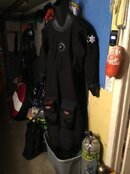FiddlerOnTheRoof
Contributor
Hi everyone,
I haven't been posting very much and I am not one to cluter the forum with nonsense but this time I need your input on a few things... I have been diving since 1989 and an avid New England wreck diver since the mid 90's. Most my dives are deep cold water dives with a drysuit and twin back mount steel 100 tanks plus deco tanks etc... In 2013 I decided to take some time off from scuba but I missed it too much and last year decided to return to the depths of the ocean with a slight difference... I decided to get into sidemount!
I am a 210 pound 45 year old man with already a little bit of arthritis on my feet and so the idea of being able to carry the tanks to the water one at a time was a big incentive along with other benefits of sidemount like redundancy.
Anyway, I had a great year 2015 diving with my 7mm wetsuit but as the water got colder, and because I like diving all year I decided to buy a new drysuit and all hell broke loose! With my 7mm and my double steel 100 tanks all I needed was 4 pounds to go diving but now with the new "winter" setup I need a whopping 40 pounds of lead to be able to dive dry. I know I have gained some pounds in the last few years but 40 pounds got me by surprise. I used to only need about 27 pounds in the past so I was not happy!
Here's my problem... The way I used to dive in the past always allowed me to setup my weight in a way that it was easy for me to ditch most of my lead weights if not all in case of an emergency! The way my new sidemount system is setup it has all the weight attached and not easy to ditch. That is making me very uneasy! I tried all kinds of options but have not been able to find one that I like yet. I tried splitting some into a weight belt but it doesn't seem to fit very well with the Hollis sms75.
Here's how I have my weight setup on my sms75:
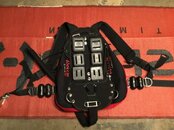
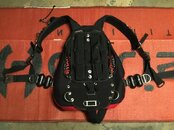
I insert those weights in that order into the pockets because of balance including the 4 two pounders around the belt.
I also always dive with my double steel 100's and each weigh 45.4 pounds.
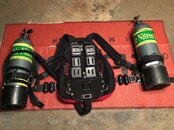
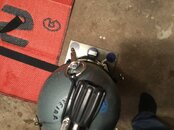
So when you do the math with just the lead weights and 2 tanks I am carrying a whopping 130.8 pounds minimum to get me under water with my drysuit!
I would like to find a way of being able to ditch most lead weight in case of an emergency while diving dry. I'm not so worried when I dive with the 7mm because it's only 4 pounds of lead but otherwise with the way I have the weigh setup with the drysuit my only other option would be to ditch it all. That would suck because I would potentially lose all my gear. One thing I have not tried yet are the weight pockets you can buy to attach to the waist belt from Hollis or Diverite and was wondering if any of you use the sms75 with such weight pockets or if you have any ideas how to resolve my problem? Any constructive ideas and/or constructive criticism is welcomed and if you have photos to go with your ideas would also be great.
Thanks for your help.
I haven't been posting very much and I am not one to cluter the forum with nonsense but this time I need your input on a few things... I have been diving since 1989 and an avid New England wreck diver since the mid 90's. Most my dives are deep cold water dives with a drysuit and twin back mount steel 100 tanks plus deco tanks etc... In 2013 I decided to take some time off from scuba but I missed it too much and last year decided to return to the depths of the ocean with a slight difference... I decided to get into sidemount!
I am a 210 pound 45 year old man with already a little bit of arthritis on my feet and so the idea of being able to carry the tanks to the water one at a time was a big incentive along with other benefits of sidemount like redundancy.
Anyway, I had a great year 2015 diving with my 7mm wetsuit but as the water got colder, and because I like diving all year I decided to buy a new drysuit and all hell broke loose! With my 7mm and my double steel 100 tanks all I needed was 4 pounds to go diving but now with the new "winter" setup I need a whopping 40 pounds of lead to be able to dive dry. I know I have gained some pounds in the last few years but 40 pounds got me by surprise. I used to only need about 27 pounds in the past so I was not happy!
Here's my problem... The way I used to dive in the past always allowed me to setup my weight in a way that it was easy for me to ditch most of my lead weights if not all in case of an emergency! The way my new sidemount system is setup it has all the weight attached and not easy to ditch. That is making me very uneasy! I tried all kinds of options but have not been able to find one that I like yet. I tried splitting some into a weight belt but it doesn't seem to fit very well with the Hollis sms75.
Here's how I have my weight setup on my sms75:


I insert those weights in that order into the pockets because of balance including the 4 two pounders around the belt.
I also always dive with my double steel 100's and each weigh 45.4 pounds.


So when you do the math with just the lead weights and 2 tanks I am carrying a whopping 130.8 pounds minimum to get me under water with my drysuit!
I would like to find a way of being able to ditch most lead weight in case of an emergency while diving dry. I'm not so worried when I dive with the 7mm because it's only 4 pounds of lead but otherwise with the way I have the weigh setup with the drysuit my only other option would be to ditch it all. That would suck because I would potentially lose all my gear. One thing I have not tried yet are the weight pockets you can buy to attach to the waist belt from Hollis or Diverite and was wondering if any of you use the sms75 with such weight pockets or if you have any ideas how to resolve my problem? Any constructive ideas and/or constructive criticism is welcomed and if you have photos to go with your ideas would also be great.
Thanks for your help.




